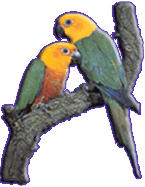|
|
| |
|
|
|
|
PRINCESS PARROT
Polytelis Alexandrae |
|
|
| |
|
Princess parrots are restricted to the inland regions of western and central Australia. They inhabit plains often situated far from water. While flying, finding food, and eating these parrots are very quiet. However, when the moving period comes, they are making noise as long as they do not find suitable tree. Their way of camouflage is to snuggle up to the branch of the tree. That is how they are 2 hiding 2 from any potential danger. |
|
|
Princess, the bird with delicate-pastel colorings, can be kept in outdoor aviary, for it can bear low temperatures. It does not have wild temperament and it is not shy, either. Keeping Princess indoor also means providing enough free space, because Princess has long and graceful tail. If it gets that space, it will show all its beauty and charm in flight, and you will have dancing colors in front of your eyes. |
|
|
Cages and voliers can be made of wood, since this species does not find anything interesting in biting the wood. Moreover, Princess parrots have calm and gentle temperament, so you can keep two pairs of this species in one aviary, or even a pair of Princess with a pair of Smokers or Singing parrots. |
|
|
|
They should be fed millet, canary seed, hemp, oat, sorghum, maze, apple, carrots, spinach, sparsely, and so on. In breeding period, they should get plenty of germinating grain as well as mixture of hard-boiled egg, poppy and cookies. Princess have a very bad habit of pecking the germinating grains from the ground, and that is the best way of getting intestinal disorder (like infections by parasitic worms). Concurat and Panacur are usually used both as a treatment and as preventive. Princess gets fully matured at the age of two. This species have specific and very interesting courtship. The male is trying to feed the female by rocking from side to side and hopping around her. While doing his ritual dance of love, male is singing very nice love song. All this becomes more interesting when the male starts contracting his eye pupils into the little spots, while the rest of the eye gets red orange color.
When nesting in the wild, female lays 4 to 6 white eggs into the stump of the tree. Incubation period lasts for 20 to 21 day. Juveniles are fully feathered five weeks after hatching, and in the same time, they leave the nest. Youngsters stay for one more moth with their parents, and after that period they are leaving their parents for good.
|
|
|
Princess is 45 cm long and two thirds of its size goes on the tail. Male has a bit longer tail feathers then the female and the third pair of the primaries is enlarged by 12 to 14 mm. This feather length difference is the basic difference between genders. Female's neck is grayish to pale violet, and the green wing feathers are streaked with dark olive-green. Forehead and crown are blue, crop is pink-violet, breasts yellowish green. The upper wings are plaiting of green shades, with open green feathers over it. The tail is on its upper part blue-green. While the Princess is standing on the branch with its tail puckered, it seems like it has just one tail feather. Tail inners are very rare in parrot's world. All tail feathers are half black and half cyclamen color, and this color division is over the length of the tail. These tail colorings are most impressive when Princess is flying, and thanks to the nature, we can enjoy in this spectacular sight, too. Beak of Princess parrot is relatively small comparing the whole size of a bird, it is rosy and the upper mandible is slightly bent down, so it is more similar to the beak of neofema. |
|
|
This parrot species does not have ability to imitate human's talk, however for its gentle arias and songs, Princess is one of the most wanted and usually kept feathery pets. Princess is friendly, easy to tame and always ready for games. On the other hand, Princess is not shy and does not know how to bite, as other parrot species do. These characteristics are, on my opinion, enough to make a choice and take one of these beauties to be your feathery friend. Princess has only one special condition and that is tall cage because of its extraordinary tail, that, I am sure, you would not like it to be ruined. About two weeks after getting this great bird, you should let it out from the cage, and you will see how gentle temper your Princess has when it gets to your shoulder or start eating from your hand.
This parrot species have several mutations: blue, yellow, olive and albino. On my opinion, the most beautiful Princess is in its natural pastel colorings full of contrast. |
| |
|
|
| |
|
|
| |
|
|
| |
|
|
|
| |
|
|
|
|
|

